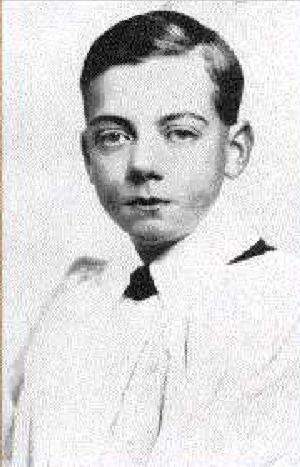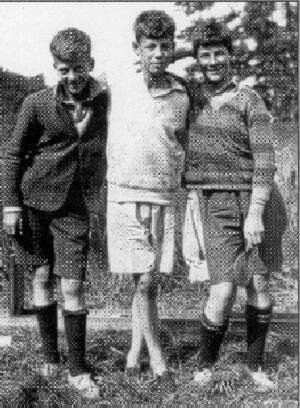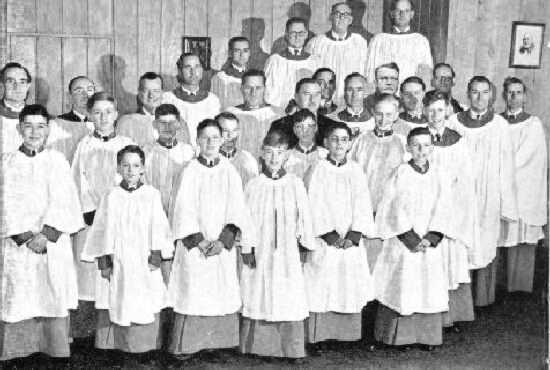
Figure 1.-- Ernest Lough as boy chorister is pictured here at age 16. Today few choristers maintain their voices after age 13, creating a major problem for boy choirs.


Figure 1.-- Ernest Lough as boy chorister is pictured here at age 16. Today few choristers maintain their voices after age 13, creating a major problem for boy choirs. |
Ernest Arthur Lough is believed to be the most famous choir boy in the world. One HBC reader reports, "Having been able to listen to some of his recordings, I would even say the best ever!" Ernest was
known as, "The boy who sang 'O for the Wings of a Dove'". Ernest was born November 11, 1911 and became a chorister at the Temple Church in London in 1923 and enrolled at the City of London School which is where the Temple choristers were traditionally educated.
Ernest Arthur Lough was born November 11, 1911. We have no information at this time about his family and early childhhod.
Ernest was accepted into the choir of the Temple Church in London in 1923 at about age 12, rather old for a chorister. Ernest and his fellow choristers would leave school at 3.30 pm, every day except Wednesday, for choir training at Temple Church. After practice on Sundays there was normally half an hour before the service, so the boys would go down to the Temple gardens to play a bit before singing Matins. Lough looking back believed that this 'run-around' actually had a good impact on their singing. "We would return to the church exhausted with sweat running all over our collars. Maybe it was some
kind of treatment."
Ernest by 1927 had become one of the soloists in the Temple choir. He was not the only soloist. The Choir at the time had several fine choristers who also sang solos. These boys included: Denis Barthel and Thomas Meddings. oir experts, however, believe that Ernest's voice stands as perhaps the finest example of the English Boy Soprano sound that has ever been recorded. His "Hear My Prayer" by Mendelssohn was recorded twice. Despite the quality of the recordings, they have never been out of print. Over 6 million copies of the 1927 and 29 recordings have been sold.
1928.
One of the problems of modern boy choirs is that boys are today maturing at an earlier age, cutting short their life as accomplished choristers. No-one was sure how long Ernest's voice would last. He was still singing string at age 15. There were signs in 1927 that his voice breaking. Ernest was able, however, to keep singing through to age 17, a phenomenon which is unheard of today. He made some of his finest records, including "Hear My Prayer" during March 1928.
Ernest reportedly never let fame go to his head. Ernest and other choristers always looked to Sir George Thalben-Ball as the source of their success. They greatly respected their Choirmaster and affectionately called him "Doctor".

Figure 2.--Ernest and his friends from the Temple Choir are seen here in 1928. If the reported date is correct, Ernest was 16 years old at the time. The boy in the middle appears to be wearing the gym uniform. The boy on the right may be wearing a rugby shirt. The photograph was taken on an outing near Angmering in Sussex. |
We have very limited information on Ernest's boyhood clothing at this time. If the attaved photograph is correctly dated, Ernest and his fellow coristers were all wearing short trouser at age 16. Presumably this was the uniform of the City of London School. HBC believes that the boys were photographed in their school uniform, both a suit and gym kit. A HBC reader thinks that the image does not show their school uniform, "I don't think they were wearing school uniform, just dressed for some party in the country." This is possible, but in 1920s, British boys did not have the extensive wardrobes that is the case today. Thus there school clothes often were also there regular everyday clothes.
Ernest was educated at the City of London School. This was the school where the Temple choristers were traditionally educated.
Ernest's voice had an important impact on choral music in Britain. Recordings were by the 1920s widely available. Thus large numbers of British boys were exposed to Ernest's voice. One observer contends that there were few English people that never heard at some time in their lives his great recording of Mendelssohn's "Hear My Prayer". Certainly many boys were inspired to become choristers after hearing Ernest's voice? Sir David Willcocks, for one, claimed that when he was a boy, it was Lough's voice that inspired his love of music as a boy.
Some music specialists believe that Ernest's voice was not vocally
unique. A fellow chorister, Jack Salisbury, said, "It was not Loughıs voice, but the use he made of his voice." Whatever the reason, Ernest's captured the popular imagination of English music lovers as no other chorister.
"I am quite sure that no boyıs voice has ever been recorded nearly as well as this, and I am equally sure that I have never heard such a beautiful voice," wrote noted critic , Sir Compton Mackenzie. [The
Gramophone, July 1927.] The Temple Church became so well attended, that when Ernest sang, tickets had to be issued for the services.
The modern cathedral choir does not follow a clear contendium from the mideval boy choirs rescruited by important monestaries and cathedrals. The standard of music before 1842 in English cathedrals was very poor. The modern choir is in fact a Victorian tradition. It was in 1842 that the Temple Church, the private chapel of the Benchers of the Inner & Middle Temple, was in the process of restoration. It was decided, almost by accident, that a surpliced choir should be introduced, for the first time since the Reformation. A choir of six boys and three gentlemen sang at the reopening of the church November, 20, 1842. Only a few months later, on May, 7, 1843, Dr E.J. Hopkins was appointed Organist and Choirmaster, and it was he who set the high standard of choral training that has remained an English tradition to this day. It created a sensation. MNo less a personage than Prince Albert turned up unannounced to listen to a choir practice.

Figure 3.--Ernest and his wife is pictured here with their three sons. The younger boy, Robin, had a particularly beautiful voice. |
Ernest greatly benefitted from technical improvements in music recording during the late 1920s. Microphone recording which provided much improved quality had only recently replaced the old acoustic recording method. This was the same basic technology used until after World War II, stereo recordings appeared in the 1950s. Ernest's first recordings were made on March 15, 1927. It was during December recording sessions that Ernest made probably his most demanding recording, "I Know that My Redeemer Liveth," from Haendel's Messiah.
The English public did not forget Ernest after his career as a christer. He reports still receiving gifts 40 years after he sang his last solo as a choir boy. Many were reacting to the recordings, being totally unaware of when they were made or how old Ernest was. He thus received gifts suitable for a choir boy such as sweets (candy) and comics. After he left the Temple choir in 1928, Ernest he began a successful career in advertising.
Ernest during World War II served as a fire fighter during the height og the NAZI Blitz on London. He was on duty on the night in 1941 when his beloved Temple Church was destroyed.
Ernest returned to the rebuilt Temple Church after the War as a bass baritone. His son Peter was a treble at the Chapel Royal. His other two boys, Graham and Robin joined their father at the Temple Church.
Ernest as an adult, as he had been as a boy, was a gently spoken person. His courtesy and self deprecating humor, assisted him in dealing for more than 60 years with endlessly repeated questions about his life as a choir boy. Particularly that one day, April 5 1927, that he made his first recording and affected the rest of his life.

Figure 4.--This photograph of the Temple Church Choir was taken in 1955. Ernest as an aduly is yhe third from left, back row. His son Robin is the second from the left, front row. |
Ernest Lough married in 1938. He died after a short illness and is survived by his wife and three sons, Peter, Graham, and Robin. All three boys were gifted with beautiful voices. Robin in particular reprtedly had a wondeful soprano voice. Denis Barthel noted the similarity of Robin's voice to that of his father "All thanks to Dr Ball", he added.
A reader comments, "A wonderful write-up! I have a CD which is the re-mastered 1928 recording of Lough singing Mendelssohn's "O for the Wwings of a Dove", and his voice is
indeed all you have said. It is true, as you noted, that boys' singing voices used to break much later in the olden days. Bach sang treble until he was almost 18!"
Another reader suggests that HBC readers interested in Ernest's music should buy a copy of Better Land Vol. 4 from either S. Beet or Amphion, it's a marvel on which can be found several songs by Ernest, particularly this extraordinary "I Know that My Redeemer
Liveth" as well as "Hear ye Israel" that became the favourite of Ernest and that he had to learn in half an hour during a recording session, just to fill in free wax! Half an hour to produce a marvel, extrodinary.
HBC has been unable to find much information about Ernest Loung. The primary source used was the work of Stephen Beet, the producer of those extraordinary CD's on british trebles from 1914 to 1957 ("The Better Land"). The information is abstracted from a booklet accompanying the CD which has also been posted on the internet.
Navigate the Historic Boys' Clothing Web Site:
[Return to the Main prodigy A-L page]
[Return to the Main individual prodigy page]
[Introduction]
[Activities]
[Bibliographies]
[Biographies]
[Chronology]
[Clothing styles]
[Countries]
[Contributions]
[FAQs]
[Glossaries]
[Boys' Clothing Home]
Related Chronolgy Pages in the Boys' Historical Web Site
[Main Chronology Page]
[The 1880s]
[The 1930s]
[The 1940s]
[The 1950s]
[The 1960s]
[The 1970s]
[The 1980s]
Navigate the Historic Boys' Clothing Web style pages:
[Kilts]
[Caps]
[Sailor suits]
[Sailor hats]
[School uniform]
[Scout]
